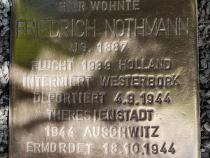Friedrich Fritz Nothmann was born on 18 October 1887 in Gleiwitz, Silesia, the son of Adolf Nothmann and his wife Alwine, née Lustig.
He attended the Königliche Wilhelms-Gymnasium and studied law in Berlin, becoming a Prussian court assessor in 1914. He took part in the First World War and married Charlotte Antonie Schneider in 1916; their daughter Hildegard Beate was born in 1920.
He became a district court judge in 1921.
His wife died in 1923 and he married Gertrud Bernhard for the second time in 1926. Their sons were born: Karl Andreas on 11 November 1926 and Georg Albrecht Leonhart on 30 January 1932. The family lived in Wannsee at Moltkestraße 10 (later Hugo-Vogel-Straße 12) in the house of Gertrud Nothmann's parents.
In 1929, Friedrich Nothmann became a chamber court judge and judge of the 2nd Senate of the Berlin Chamber Court in Schöneberg (there is also a Stumbling Stone for him here).
In March 1933, he was mobbed and beaten by Nazis in a street near Kleist Park. On 13 July 1933, like so many others, he was dismissed as a judge by the Nazis.
His father-in-law died in 1937 and Friedrich Nothmann was imprisoned in Buchenwald concentration camp after the Reichspogromnacht in 1938.
Because the family managed to emigrate to the Netherlands in January 1939, he was released in December 1938.








